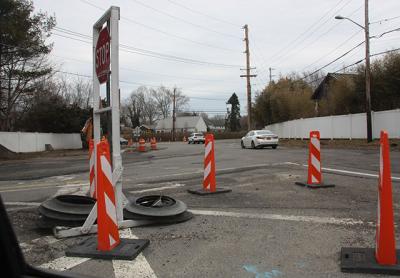Dueling Work on Rail and Roads in East Hampton

Work on the roundabout being constructed at what is known as the five corners intersection of Route 114 and Buell and Toilsome Lanes in East Hampton Village may have seemed a bit dormant this winter, but the project has been making progress off site with the fabrication of granite and concrete curbs for the circle and its splitter islands. “We’ve just completed phase two and we expect phase three to begin by early next week,” Becky Molinaro Hansen, the village administrator, said on Monday. “The goal is to have it completed hopefully by mid-May but certainly by Memorial Day.”
Phase three will include the installation of the center island, curbs, sidewalks, light poles, signs, and fixtures. There may be intermittent traffic snarls at the location due to work being done, Ms. Hansen said, but added that she does not ever expect a complete shutdown. “We anticipate being able to have at least one lane open at all times,” she said. Another key part of phase three will be the landscaping. On that front, Ms. Hansen said the village had already reached out to the Ladies Village Improvement Society and the Garden Club of East Hampton for their advice. “We want it to look like a beautiful finished product,” she said.
The other major traffic-related project in the village involves the replacement of the railroad trestles that cross North Main Street and Accabonac Road. The trestles, which are renowned for being rammed by too-tall trucks, will be raised from 11 to 14 feet high with the installation of new bridges. The Metropolitan Transit Authority, which operates the Long Island Rail Road, is in charge of the project, which is expected to take 18 months to complete, finishing in mid-2019.
Work on the retaining walls used to prop up the bridges will begin in the coming weeks, Ms. Hansen said. The walls will be constructed out of concrete blocks that “will look like rocks and vary in size and shape,” Ms. Hansen said. At a meeting in September, the village board questioned L.I.R.R. officials about whether the blocks could be dyed to a color that is aesthetically appropriate to the village’s character. The railroad officials were initially doubtful that could be accommodated, but Ms. Hansen said that the board and Robert Hefner, the village director of historic services, ultimately did get to sign off on the earth-toned shade of the blocks. “Everyone’s happy with the color,” said Ms. Hansen, who revealed that its official name is Federal Standard.
The trestle removal and replacement process, which will take about 10 days, was slated to happen this fall, but Ms. Hansen said that has been pushed back to next February. “The North Main Street bridge will be first and then five days later the Accabonac bridge,” Ms. Hansen said. “We anticipate road shutdowns during the actual removal and replacement of each trestle. The L.I.R.R. will develop a traffic control plan and review it with the village and other stakeholders.”
